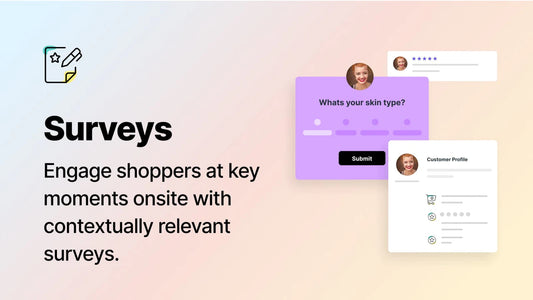If properly implemented, voice commerce—the ability to search, find, and purchase an online product using only your voice—can put Shopify store owners way ahead of their competition.
Statista predicts that there will be over 8.4 billion voice assistant units in use in 2024. The evolution of voice technology and increased consumer comfort with voice assistants have propelled voice shopping into a mainstream channel for eCommerce.
But a lack of understanding of the technology, and a poor user experience, have initially led to slow adoption rates. However, by 2024, these challenges have been largely overcome, making voice commerce a critical component for Shopify stores.
Shopify store owners in implementing voice commerce in their stores.
In this article, we’re going to tell you exactly what voice commerce is, why it’s important, and exactly how to implement voice commerce for your Shopify store. (Hint: It’s super easy.)

What is Voice Commerce?
Voice commerce, now a prevalent method for voice shopping, allows users to search, find, and purchase products using only their voice. With the sophistication of backend technology, its implementation on websites like Shopify has become streamlined and user-friendly.
How does Voice Commerce Work on Shopify?
Voice commerce on Shopify offers a seamless integration where buyers can use voice commands to interact with stores. For instance, a customer could say, “Alexa, open My Wonderful Clothing Store,” and proceed to make selections and purchases entirely through voice interactions as follows:
Buyer: “Alexa, open My Wonderful Clothing Store.”
Alexa: “Sure, what are you looking for?”
Buyer: “I need men’s clothing, please.”
Alexa: “Showing men’s category.”
Buyer: “Great. I need a new t-shirt.” (Note the natural flow of language which is the keynote of properly implemented voice commerce.)
Alexa: “Sure, there are 57,287 items matching your request. Do you want to apply some filters?”
Buyer: “I need a medium-sized pink shirt.”
And so it would go, flowing with easy conversation, and ending off with the Shangri-La of phrases for any Shopify store owner: “Please add that shirt to my basket and check it out using my personal credit card.”
Done. Purchased.
And there’s a bonus: The voice assistant will likely then ask the buyer if they'd like to be reminded to purchase again in the future. This is particularly useful for Shopify stores that sell goods such as groceries.

What are the Benefits of Voice Commerce for Shopify Owners?
1. Convenience
Voice Commerce offers checkouts that are 4X faster. Product searches are also 75% faster when done via voice.
You can also interact with your device from anywhere—from the car when you’re driving and aren’t allowed to touch your phone; from the kitchen when your hands are full of flour; or when you’re just too lazy to get up from the couch after a long day’s work. Wouldn’t that be the perfect time to say, “Hey, Alexa, order me a pack of bath salts, sent with priority delivery”? 😉
2. First-to-market advantage
Due to its novelty in the market, voice commerce on Shopify stores is still a largely untapped sector. By implementing voice commerce on your Shopify store, you’ll instantly put yourself ahead of the competition.
3. Low-cost implementation
Although the technology required to implement sophisticated voice commerce on your Shopify store is immense, the business model to do it is based on approachable costs for the end-user.
Implementing voice commerce on your Shopify site is often far cheaper than trying to optimise the checkout process. Depending on what an optimisation specialist finds on your website, that cost could go up to thousands of pounds.
To more affordably improve conversion rates immediately, just implement an easy voice commerce solution. (Hint: Voiceflip)
4. Reorder rate
The Voiceflip voice search engine also sends voice notifications reminding you to purchase an item that might be running low.
For example, let’s say you order a 30-day supply of coffee. You can set up your voice commerce solution to send a notification 21 days after purchase, to remind the user to purchase again.
Alexa: “Your supply of Acme Coffee might be running low. Do you want me to place a new order for it?”
Buyer: “Yes.”
Done.
5. Personalised experience
Voice assistants are AI-based, meaning they learn from your voice patterns and from human language in general. The ultimate goal of voice assistant providers is to make the interaction between humans and devices feel completely natural and comfortable.
This sense of ease makes the user feel like they’re asking a friend for something when they place an order, thereby further increasing order rates and conversion rates.
Tips for Implementing Voice Commerce
- Emphasise natural language processing to enhance the ease of voice shopping
- Regularly update and maintain your voice commerce system for optimal performance
- Ensure that voice commerce seamlessly integrates with other Shopify functionalities
What Does the Future of Voice Commerce Hold?
The future of voice commerce is marked by significant advancements and wider adoption:
- Deeper AI and Machine Learning Integration to provide more personalised and accurate voice shopping experiences, adapting to user preferences and behaviours.
- Broader Market Penetration as voice commerce extends beyond retail to include services, bookings, and B2B interactions, increasing its utility and reach.
- Improved Voice Recognition Technology enhancing understanding and response accuracy for diverse accents and languages, making voice commerce more globally accessible.
- Enhanced Security Features with the integration of voice biometrics and other advanced authentication methods to ensure safe and secure transactions.
- Integration with Emerging Technologies like augmented reality (AR) and virtual reality (VR) for more interactive and immersive shopping experiences.
- Voice-Activated IoT Commerce enabling seamless shopping experiences across various connected devices, further integrating voice commerce into daily life.
How do I Integrate Voice Commerce with my Shopify Store?
Implementing voice commerce on your Shopify store is as easy as installing a specially designed add-on to your website, provided by Blend Commerce.
The add-on represents a middleware solution between your Shopify store and the voice assistant. When you speak to your assistant, the add-on processes the voice input, sends it to our servers, “crunches the numbers” so to speak, and sends back an answer.
The voice assistant then gives this answer to the user.
For the add-on to understand what the user is asking about your store, it must perform an extensive (albeit, entirely automated) analysis of the products on your store. Often, the add-on finds many errors, and it cleans them up and organises everything to make understanding voice searches easier.
Every month, the add-on checks your site to make sure that everything is still properly categorised, described, and optimised so that searches using human language are easy to process.
All of this is done without you having to worry about it.
To implement voice commerce on your Shopify store, give us a no-obligation call.







